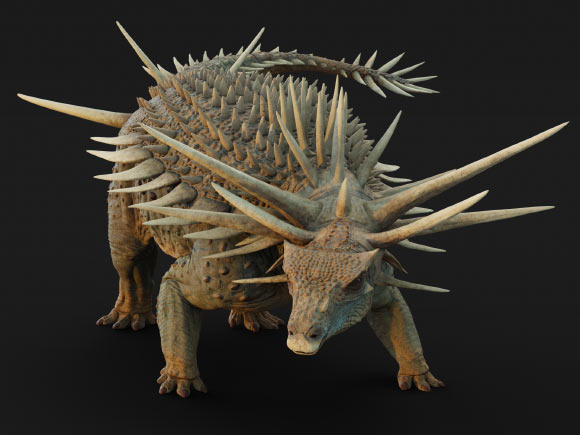The armored ankylosaurian dinosaurs are best known from Late Cretaceous northern hemisphere ecosystems, but their early evolution in the Early-Middle Jurassic is shrouded in mystery due to a poor fossil record. Spicomellus afer was suggested to be the world’s oldest ankylosaur and the first from Africa, but was based on only a single partial rib from the Middle Jurassic of Morocco. Now, paleontologists have described a new, much more complete specimen that confirms the ankylosaurian affinities of Spicomellus, and demonstrated that it has uniquely elaborate dermal armor unlike that of any other vertebrate, living or extinct.
Spicomellus afer lived in what is now Morocco during the Middle Jurassic period, some 168 million years ago.
The initial description of this species was published in 2021 and was based on one fossilized rib bone.
“Seeing and studying the Spicomellus fossils for the first time was spine-tingling,” said University of Birmingham’s Professor Richard Butler.
“We just couldn’t believe how weird it was and how unlike any other dinosaur, or indeed any other animal we know of alive or extinct.”
“It turns much of what we thought we knew about ankylosaurs and their evolution on its head and demonstrates just how much there still is to learn about dinosaurs.”
Professor Butler and colleagues found that Spicomellus afer had bony spikes fused onto and projecting from all of its ribs, a feature not seen in any other vertebrate species living or extinct.
The ancient animal had long spikes, measuring 87 cm, which the authors believe would have been even longer during the animal’s life, that emerged from a bony collar that sat around its neck.
“To find such elaborate armor in an early ankylosaur changes our understanding of how these dinosaurs evolved,” said Professor Susannah Maidment, a paleontologist at the Natural History Museum, London, and the University of Birmingham.
“It shows just how significant Africa’s dinosaurs are, and how important it is to improve our understanding of them.”
“Spicomellus had a diversity of plates and spikes extending from all over its body, including meter-long neck spikes, huge upwards-projecting spikes over the hips, and a whole range of long, blade-like spikes, pieces of armor made up of two long spikes, and plates down the shoulder.”
“We’ve never seen anything like this in any animal before.”
“It’s particularly strange as this is the oldest known ankylosaur, so we might expect that a later species might have inherited similar features, but they haven’t.”
The researchers postulate that this array of spikes would have been used for attracting mates and showing off to rivals.
Interestingly, similar display armor has not yet been found in any other ankylosaur, with later species possessing armor that probably functioned more for defence.
One explanation for this is that as larger predatory dinosaurs evolved in the Cretaceous period, as well as bigger carnivorous mammals, crocodiles and snakes, the rising risk of predation could have driven ankylosaur armor to become simpler and more defensive.
One feature of early ankylosaurs that may have survived, however, is their tail weaponry.
While the end of Spicomellus’ tail hasn’t been found, the bones that do survive suggest that it had a club or a similar tail weapon.
Some of the tail vertebrae are fused together to form a structure known as a handle, which has only been found in ankylosaurs with a tail club.
However, all these animals lived millions of years later in the Cretaceous.
The combination of a tail weapon and an armored shield that protected the hips suggest that many of the ankylosaurs’ key adaptations already existed by the time of Spicomellus.
The discovery reinforces the importance of the fossil record in solving evolutionary puzzles and deepening our understanding of the geographic distribution of dinosaurs.
It also helps to spark public imagination in dinosaurs as we learn more about the baffling characteristics of species like Spicomellus.
“This study is helping to drive forward Moroccan science,” said Professor Driss Ouarhache, a paleontologist at the Université Sidi Mohamed Ben Abdellah.
“We’ve never seen dinosaurs like this before, and there’s still a lot more this region has to offer.”
A paper about the discovery was published today in the journal Nature.
_____
S.C.R. Maidment et al. Extreme armour in the world’s oldest ankylosaur. Nature, published online August 27, 2025; doi: 10.1038/s41586-025-09453-6








